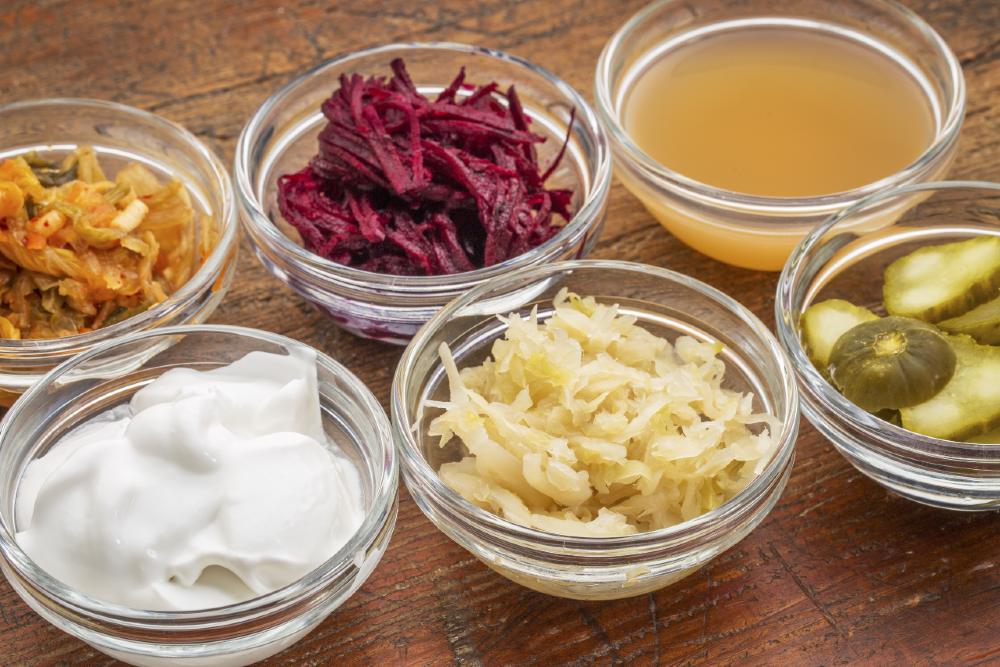5 Fermented Foods to Add to Your Prenatal Diet

But in the past decade or so, science has begun to recognize that all the amazing benefits of a healthy microbiome go way beyond better digestion. A robust community of gut bugs has been linked to everything from improved immunity to lower cholesterol numbers to better sleep quality to less weight gain—even a more positive mental outlook, a potential ally in the battle against postpartum depression.
So, how to keep your microbiome happy? A good place to start is with your diet. Certain foods contain a population of probiotics that can help fertilize your body with good-for- you organisms. But we’ve got a gut feeling your everyday diet doesn’t include nearly enough of them. Yogurt is the most obvious way to spoon up some probiotics, but there are many reasons why you should also add the following items to your grocery cart.
Kefir
Originally hailing from Eastern Europe, think of extra tangy kefir as liquid yogurt on bacterial steroids. Typically, the effervescent dairy contains a greater diversity of beneficial bug strains and also a population that is three to four times as large. One reason for its lofty probiotic count is that kefir is cultured up to eight times longer than yogurt, giving the good bacteria more time to multiply. Since kefir’s live cultures break down a chunk of the lactose present in milk, some people find it causes fewer stomach woes than milk. You and your baby will also benefit from its high quality protein and bone- building calcium. Kefir is becoming a dairy aisle mainstay, but ideally opt for those labeled “plain” to sidestep the avalanche of sugary calories added to most flavored versions.
Eat more: Enjoy kefir by the glassful, pour it on your cereal, use it in place of milk in your overnight oats, or make it a powerful addition to smoothies.
Kimchi
Born out of a need to preserve perishable foods during Korea’s harsh winter months, crunchy kimchi is made by combining vegetables (most often napa cabbage) with a fiery garlic chili seasoning that ranges from mild to “have mercy” and then setting the mixture aside to ferment. With its burgeoning popularity among food trucks and social media, kimchi is now being made with everything from Brussels sprouts to cucumbers to turnips. Some preliminary research suggests eating kimchi may alter metabolism in favor of promoting a healthier body weight.
Eat more: In Korea, kimchi is often treated as a vegetable side dish, but you can sneak it into your menu by adding it to scrambled eggs, roasted vegetables, tacos, burgers, grilled cheese, grain bowls and even pizza.
Miso
A staple in Japanese cuisine, this paste is made by combining cooked soybeans with rice or barley, salt and koji (a starter enzyme that breaks down proteins). Traditionally, the mixture is then left to ferment for six months to three years where it develops nutty, umami goodness. Miso comes in three varieties: white, yellow and red. White and yellow miso are milder in flavor, whereas red miso, which hails from a longer fermentation process, has a more robust and saltier flavor. Salt levels can vary, so compare brands and opt for those with lower levels.
Eat more: Just a touch of white or yellow miso can crank up the flavor of salad dressings, dips, marinades, mashed potatoes and brothy soups. Try red miso in heartier dishes like stews or as a topping for roasted root vegetables. To keep the probiotics more active when making soups with miso, remove a small amount of the warm liquid and whisk the miso into this liquid. You can then add the miso liquid back to the pot at the end of cooking.
Sauerkraut
Think of sauerkraut as the Western version of kimchi. It’s made by submerging cabbage in salty brine for several days, which allows bacteria, including lactobacillus, to perform essentially controlled decay. As an added perk, sauerkraut is a good source of immune-boosting vitamin C. In its most basic form, sauerkraut is just cabbage and salt, but gussied-up versions featuring nice add-ins like carrots and beets are now becoming available. Choose only refrigerated options; shelf-stable versions have likely been heat treated, which kills off the probiotics. Or, go ahead and make it your first DIY fermentation project: It requires very little skill and equipment beyond a large jar, salt and a nice head of green cabbage.
Eat more: Sauerkraut can instantly jazz up sandwiches, coleslaw, hash browns, tacos, cooked grains, burgers and pork chops.
Tempeh
This meaty tofu counterpart is made by packing fermented soybeans into patties. Beyond its probiotics, tempeh has higher protein (about 16 grams in 3 ounces), vitamin B12 and fiber numbers than humble tofu. Fermentation also reduces levels of phytic acid, a substance naturally found in soy that can prevent your body from fully absorbing its nutrients. Its flavor can be best described as smoky, nutty, and earthy in a mushroom kind of way. Some tempeh patties are made with seasonings and other items like vegetables and rice.
Eat more: Slabs of tempeh can be grilled just like steak or chicken, so try grilled tempeh as a replacement for meat in burgers and sandwiches. You can also crumble it up and add it to chilis, tacos, casseroles and pasta sauce.







